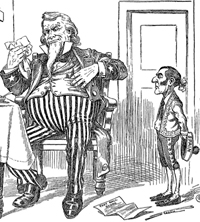American Personalities: Uncle Sam and Lady Liberty
Uncle Sam and Lady Liberty—for over a century, these two characters have personified the United States and popular conception of the nation’s ideals. Answer these questions about the roles these characters have played, including soldier, tyrant, police officer, financier, judge, deity, and champion of the oppressed.
1. What characters have political cartoonists used to represent the English counterparts to Uncle Sam and Lady Liberty?
c. John Bull and Britannia.
 Wearing breeches and a Union Jack waistcoat, John Bull once served as the symbol for the British everyman, but evolved into a symbol of the country as a whole. Both Britannia, the goddess-like female figure of England, and John Bull often appeared in political cartoons with Uncle Sam or Columbia—another name for Lady Liberty.
Wearing breeches and a Union Jack waistcoat, John Bull once served as the symbol for the British everyman, but evolved into a symbol of the country as a whole. Both Britannia, the goddess-like female figure of England, and John Bull often appeared in political cartoons with Uncle Sam or Columbia—another name for Lady Liberty.
2. This version of Uncle Sam appeared in a Denver Evening Post cartoon in November 1898. Uncle Sam is usually drawn as a skinny character. Why is he fat here?
b. He has just finished consuming overseas territories, such as Hawaii, Puerto Rico and the Philippines.
 In a spree of imperialism, the United States, represented by Uncle Sam, has "consumed" Hawaii (annexed to the U.S. on July, 1898), as well as Puerto Rico and the Philippines (though the Treaty of Paris and the acquisition of these as territories was still in debate in November 1898). Now, Uncle Sam turns to the figure of Spain—the cartoon's caption has him say, "Now, young man, I'll attend to your case." With the Spanish-American War over, the glutted U.S. prepares to attend to Spain itself, not just its colonies.
In a spree of imperialism, the United States, represented by Uncle Sam, has "consumed" Hawaii (annexed to the U.S. on July, 1898), as well as Puerto Rico and the Philippines (though the Treaty of Paris and the acquisition of these as territories was still in debate in November 1898). Now, Uncle Sam turns to the figure of Spain—the cartoon's caption has him say, "Now, young man, I'll attend to your case." With the Spanish-American War over, the glutted U.S. prepares to attend to Spain itself, not just its colonies.
3. When did political cartoonists draw Uncle Sam as a self-appointed global policeman?
d. During the "Imperialist" phase of U.S. foreign affairs, beginning prior to the Spanish-American War.
 In the years leading up to the Spanish-American War and the U.S. metamorphosis into an imperialist world power, Uncle Sam was often drawn as a police officer. However, cartoonist Thomas Nast had already pictured Uncle Sam as a cop on the beat, policing U.S. political corruption, as early as 1888.
In the years leading up to the Spanish-American War and the U.S. metamorphosis into an imperialist world power, Uncle Sam was often drawn as a police officer. However, cartoonist Thomas Nast had already pictured Uncle Sam as a cop on the beat, policing U.S. political corruption, as early as 1888.
4. When Uncle Sam first appeared, he was drawn to resemble:
a. An old gentleman in knee breeches.
 For several decades, Uncle Sam was indistinguishable from an earlier character, Brother Jonathan, who also represented the U.S., superceding Yankee Doodle. By the middle of the 19th century, the same figure-by then clad in striped pants, short jacket, and top hat—was sometimes called Uncle Sam and sometimes Brother Jonathan. By about 1875, "Brother Jonathan" had mostly disappeared.
For several decades, Uncle Sam was indistinguishable from an earlier character, Brother Jonathan, who also represented the U.S., superceding Yankee Doodle. By the middle of the 19th century, the same figure-by then clad in striped pants, short jacket, and top hat—was sometimes called Uncle Sam and sometimes Brother Jonathan. By about 1875, "Brother Jonathan" had mostly disappeared.
5. When Columbia first appeared, she most closely resembled:
a. The goddess of liberty, Libertas.
 Often depicted in the French Revolution, Libertas wore a soft "liberty" or "Phrygian" cap. As Columbia, she could also wear feathers on her head, a reference to Native Americans, or a star or crown. The name "Columbia" fell out of popularity after World War I, and the character gained the names "Miss Liberty" or "Lady Liberty."
Often depicted in the French Revolution, Libertas wore a soft "liberty" or "Phrygian" cap. As Columbia, she could also wear feathers on her head, a reference to Native Americans, or a star or crown. The name "Columbia" fell out of popularity after World War I, and the character gained the names "Miss Liberty" or "Lady Liberty."
The Library of Congress, as part of its American Treasures exhibit, looks at the history of the famous "I Want You" World War I image of Uncle Sam. It also showcases an image, by the same artist, of Lady Liberty.
Uncle Sam and Lady Liberty have appeared regularly in political cartoons since their creation. Vassar College's 1896: The Presidential Campaign includes a subsection just for cartoons containing Uncle Sam, as does Leo Robert Klein's The Red Scare (1918-1921) (see "Uncle Sam" under subject headings). Even Dr. Seuss took his turn drawing Uncle Sam: Try June 1942 in Dr. Seuss Went to War: A Catalog of Political Cartoons. You might also try a search for the term "uncle sam" in the New York Public Library's Digital Archive.
Once you've found some resources picturing these iconic personifications, take a look at Understanding and Interpreting Political Cartoons in the History Classroom for models of classroom use.
- "Have Your Answers Ready," 1917, Library of Congress, Prints and Photographs Collection (accessed November 12, 2009).
- James Baillie, "Uncle Sam and his servants" (New York: 1844), Prints and Photographs Collection, Library of Congress (accessed November 12, 2009).






